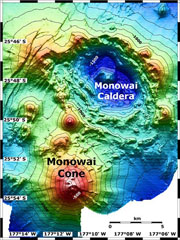Report on Monowai (New Zealand) — May 2002
Bulletin of the Global Volcanism Network, vol. 27, no. 5 (May 2002)
Managing Editor: Richard Wunderman.
Monowai (New Zealand) Strong T-waves during May 2002 indicate explosive activity
Please cite this report as:
Global Volcanism Program, 2002. Report on Monowai (New Zealand) (Wunderman, R., ed.). Bulletin of the Global Volcanism Network, 27:5. Smithsonian Institution. https://doi.org/10.5479/si.GVP.BGVN200205-242050
Monowai
New Zealand
25.887°S, 177.188°W; summit elev. -132 m
All times are local (unless otherwise noted)
The last reported activity at Monowai occurred during June 1999 when a strong acoustic crisis was recorded (BGVN 24:06). During May 2002, strong T-waves coming from Monowai were detected by the French Polynesian Seismic Network. The signal began at 1522 on 24 May and suggested explosive activity. Several small events were detected during the next two hours. No further activity was recorded following the event.
General Reference. Davey, F.J., 1980, The Monowai Seamount: an active submarine volcanic centre on the Tonga-Kermadec Ridge (Note): New Zealand Journal of Geology and Geophysics, v. 23, p. 533-536.
Geological Summary. Monowai, also known as Orion seamount, is a basaltic stratovolcano that rises from a depth of about 1,500 to within 100 m of the ocean surface about halfway between the Kermadec and Tonga island groups, at the southern end of the Tonga Ridge. Small cones occur on the N and W flanks, and an 8.5 x 11 km submarine caldera with a depth of more than 1,500 m lies to the NNE. Numerous eruptions have been identified using submarine acoustic signals since it was first recognized as a volcano in 1977. A shoal that had been reported in 1944 may have been a pumice raft or water disturbance due to degassing. Surface observations have included water discoloration, vigorous gas bubbling, and areas of upwelling water, sometimes accompanied by rumbling noises. It was named for one of the New Zealand Navy bathymetric survey ships that documented its morphology.
Information Contacts: Dominique Reymond, Geophysical Laboratory, CEA/DASE, PO Box 640, Papeete, Tahiti, French Polynesia.

